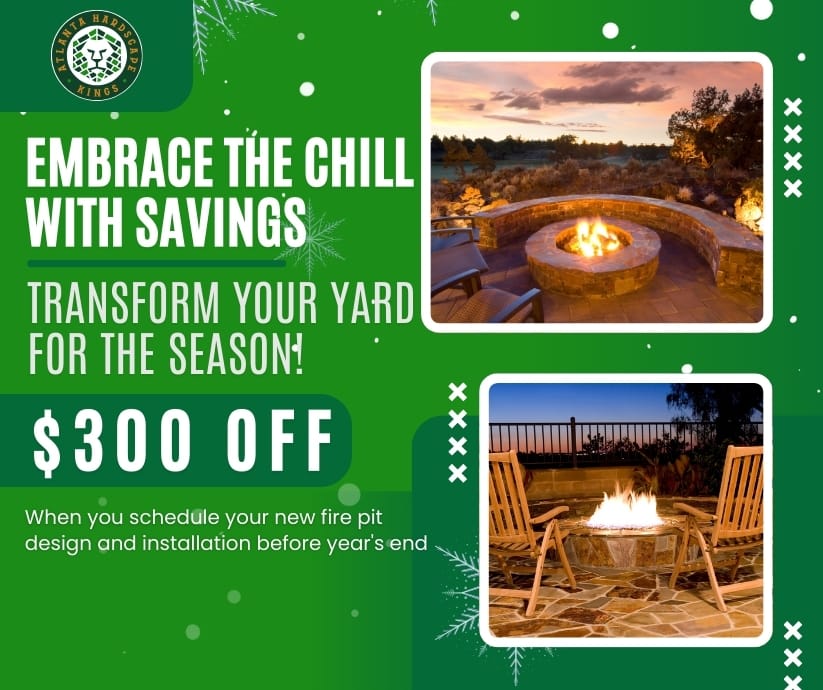In Atlanta’s dynamic climate, where sudden downpours are common and soil conditions can shift quickly, proper drainage isn’t just a detail in hardscape design; it’s a necessity. Without it, beautiful patios, walkways, and retaining walls can suffer from erosion, cracking, and water pooling that shortens their lifespan and undermines their function. Integrating smart drainage solutions into your hardscape plans ensures that your outdoor spaces not only look great but also perform well year-round. In this article, we’ll explore why proper drainage matters, what happens when it’s overlooked, and how to design hardscapes that stand the test of time in Atlanta’s unique environment.
Why Atlanta Hardscape Designs Fail Without Proper Drainage
Importance of Proper Drainage in Hardscape Designs

When creating a hardscape that marries beauty and functionality, one element stands above the rest: proper drainage. Without it, even the most meticulously planned patio, walkway, or retaining wall is vulnerable to damage from water accumulation. Proper drainage ensures surface water moves away from structures, preventing pooling and erosion that can undermine the integrity of pavers, concrete, and natural stone. In a climate like Atlanta’s—where heavy downpours are common—this critical consideration safeguards your investment by directing rainwater to designated channels and away from foundations.
Beyond protecting structural components, proper drainage is essential for preserving the aesthetic appeal of your outdoor living space. Standing water can lead to unsightly algae, mildew, and mud stains on pavers and gravel.
Over time, moisture can discolor surfaces, weaken sealants, and promote weed growth in joints. By integrating effective drainage solutions—such as French drains, channel drains, and permeable surfaces—designers can maintain a clean, safe environment for entertaining and relaxation, rain or shine.
Finally, proper drainage plays a significant role in safety and comfort. Slippery surfaces caused by water pooling pose a hazard to foot traffic, especially on steps or slopes. Effective drainage mitigates trip risks and reduces the likelihood of ice formation in cooler months. For homeowners and commercial property managers alike, investing in well-engineered drainage not only prevents property damage but also enhances functionality, making your hardscape a reliable extension of your living space.
Factors Contributing to Poor Drainage in Atlanta

Drainage problems are a frequent issue for Atlanta homeowners, and several regional factors contribute to the challenge. One of the biggest culprits is the local soil. Much of Atlanta is built on dense, clay-heavy soil that doesn’t absorb water easily. Instead of soaking into the ground, rainwater tends to sit on the surface or run off quickly. When this water collects in low spots, it can create puddles in your yard, waterlogged gardens, and even moisture problems around your foundation or basement.
The city’s changing elevation adds to the problem. Some properties sit at the bottom of hills or dips in the landscape, making them more vulnerable to runoff from nearby areas. During heavy storms, which are common in Atlanta, water can build up quickly and overwhelm the ground’s ability to absorb it. The result is flash flooding in yards, erosion around walkways, or water pooling near driveways and patios.
Urban development plays a major role as well. As more homes, roads, and driveways are added, more of the natural landscape is covered in concrete and asphalt. These hard surfaces don’t absorb water at all, which means more runoff ends up flowing overland, looking for the path of least resistance. Without proper planning, that path can lead straight to your front door.
Maintenance issues can make things worse. If your gutters are clogged or your downspouts don’t direct water away from your home, even a light rain can create problems. Blocked drains and debris-filled yard basins stop water from flowing freely and often result in water backing up onto your hardscapes.
To prevent drainage issues, it’s important to evaluate your landscape’s grading, soil conditions, and how water flows across your property. Addressing these factors early can help you avoid costly repairs down the line and protect your yard from becoming a swamp every time it rains.
Impact of Inadequate Drainage on Hardscape Structures

When drainage issues go unresolved, they can cause serious problems for patios, walkways, driveways, and retaining walls. Water that isn’t properly directed away from these structures will often collect underneath or along the edges. Over time, this constant exposure weakens the base layers that give hardscapes their strength and stability. In winter or early spring, freezing temperatures can make the problem worse. Water trapped beneath pavers or concrete expands when it freezes, then contracts as it thaws. This repeated pressure causes cracks, shifts, and heaving that leave surfaces uneven or broken.
Even in warmer months, standing water contributes to soil erosion, gradually washing away the gravel or sand base beneath your hardscapes. As that foundation erodes, pavers may sink, shift, or tilt. Not only does this make the area look poorly maintained, but it also creates tripping hazards and can lead to water being redirected in unintended ways, spreading the damage further.
Retaining walls are especially vulnerable to drainage problems. When water builds up behind the wall without proper outlets to escape, the pressure it creates can push against the structure. Over time, this hydraulic pressure may crack the wall, bow it outward, or even lead to a total collapse. In some cases, water can also weaken mortar joints or wash out the soil the wall is meant to hold in place.
Without reliable drainage systems in place—like French drains, swales, or properly sloped surfaces—these problems are likely to repeat. Homeowners may find themselves investing in frequent patchwork repairs or full replacements that could have been avoided with better planning.
To protect your outdoor spaces and extend the life of your hardscape investments, drainage should be part of the initial design and regularly maintained. A solid drainage plan keeps water moving where it should and helps you avoid expensive headaches down the road.
Common Drainage Solutions for Atlanta Hardscape Projects
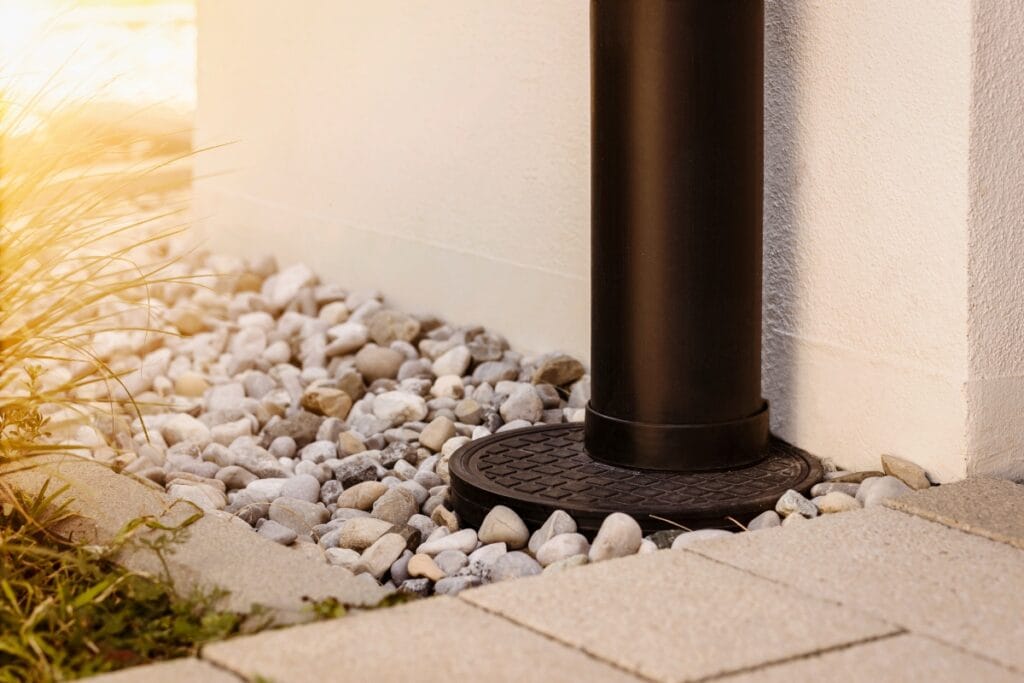
Atlanta’s heavy rainfall and dense clay soil create a tough environment for managing water around outdoor spaces. To prevent damage and maintain long-term usability, hardscape projects in the area often rely on a few key drainage strategies.
One of the most common solutions is the French drain. This system uses a gravel-filled trench and a perforated pipe to move water away from areas where it tends to collect. It is especially helpful in backyards, along retaining walls, or behind foundations where groundwater buildup can lead to erosion or structural issues.
For patios, driveways, or walkways, surface-level drainage is often necessary. Channel drains, which are long, narrow grates set into the pavement, help capture runoff before it spreads. These drains connect to underground pipes that carry water away to storm drains or designated safe zones. When installed correctly, they protect both the surface and the base of the hardscape from water-related wear.
Permeable pavers are another effective option. Unlike traditional materials that simply shed water, these pavers are designed to let it pass through into a prepared gravel base below. This not only reduces runoff but also allows more rainwater to soak into the ground, which helps reduce strain on city drainage systems. Porous concrete and asphalt work similarly and are sometimes used for driveways or parking pads.
In more landscaped areas, rain gardens and dry wells can help manage overflow. A rain garden is a shallow, planted basin that holds excess water and slowly absorbs it into the ground. Dry wells collect water underground and allow it to disperse naturally over time. Both options offer an eco-friendly alternative that blends with the landscape design.
Choosing the right combination of these systems depends on your property’s layout, soil type, and how much water you need to move. A well-planned drainage setup keeps your hardscape structures safe, minimizes erosion, and ensures your outdoor space remains usable all year long.
Designing Effective Drainage Systems for Hardscapes
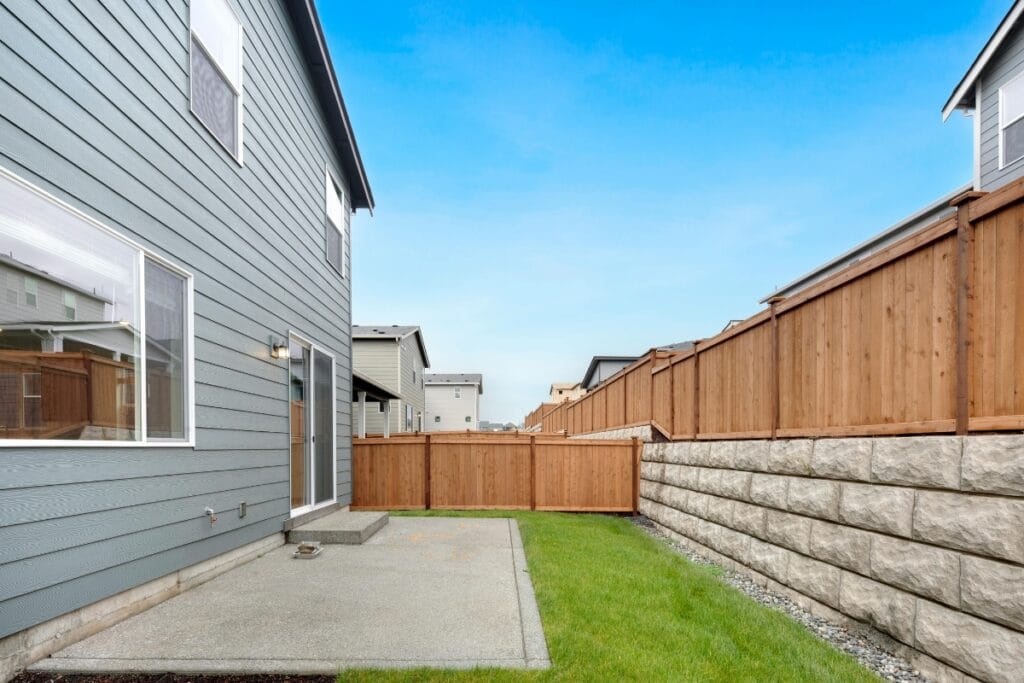
A solid drainage system starts with a good understanding of the property. Before breaking ground, contractors assess slope, soil composition, and how water naturally moves across the site. This step is critical, especially in areas with Atlanta’s dense clay soils that don’t drain easily. From there, the design must ensure that water is directed away from structures, patios, walkways, and planting beds.
Grading is one of the most important tools in this process. Using tools like laser levels, contractors can shape the landscape to create subtle slopes that guide water toward safe exit points. Even a small change in pitch can make a big difference in how water drains. A typical recommendation is to slope surfaces away from buildings at a rate of at least 1 percent (or 1 inch per 8 feet).
Next, the drainage system should combine several components to handle different types of runoff. For example, gutter downspout extensions can channel roof runoff away from foundation areas. Catch basins collect surface water in low-lying spots and connect to underground piping. French drains or other sub-surface systems work well for areas that stay wet or have poor natural drainage.
Another key factor is pipe sizing. If the pipes are too small, they won’t be able to keep up during a strong storm. That can lead to water backing up onto the surface or even causing erosion around the hardscape. Pipes must also have the proper slope and lead to an outlet that can handle the volume of water.
A successful drainage design isn’t about adding just one feature. It’s about layering solutions that work together to move water efficiently, protect structures, and keep outdoor spaces usable. When done right, it becomes a nearly invisible part of the landscape—until the next storm hits, and everything still works just as it should.
Benefits of Professional Drainage Planning and Installation
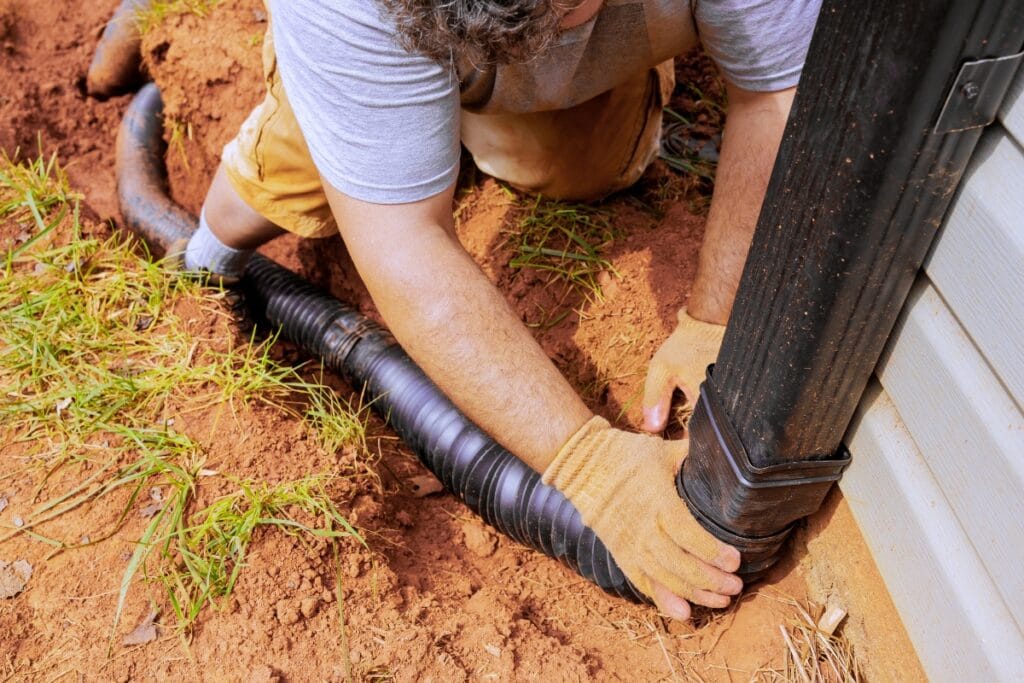
When it comes to hardscape projects, proper drainage isn’t something you want to leave to chance. Hiring experienced professionals to handle drainage planning and installation brings real value, especially in a city like Atlanta where clay-heavy soil and sudden storms can create problems quickly. Landscape architects and drainage contractors understand how water moves across a property and how to control it with lasting results.
These experts use site-specific details, like slope, soil type, and surrounding structure, to design systems that work with the land instead of against it. They also bring a solid understanding of local codes and permitting requirements, so your project won’t run into compliance issues. More importantly, they know how to spot potential trouble areas early on. Addressing those problems before construction begins helps avoid future damage to patios, driveways, or retaining walls.
Professional contractors also help with selecting the right components for your setup. Whether you need French drains, catch basins, downspout extensions, or a combination of systems, they know what works and what doesn’t in Atlanta’s climate. Their experience ensures that everything from pipe sizing to outlet placement is correct the first time, which reduces the risk of backups or erosion down the line.
Another advantage of hiring licensed professionals is the protection they offer. Most carry liability insurance and offer warranties on both materials and labor. That means if something does go wrong, you’re not left footing the bill. Many also offer ongoing maintenance services to keep your system in top shape year after year.
In short, professional drainage planning isn’t just about preventing puddles. It’s about protecting your investment, avoiding costly repairs, and ensuring your hardscape looks good and functions well over the long term. With the right team in place, you can be confident your outdoor space will hold up to Atlanta’s weather.
Maintenance Tips for Ensuring Longevity of Drainage Systems
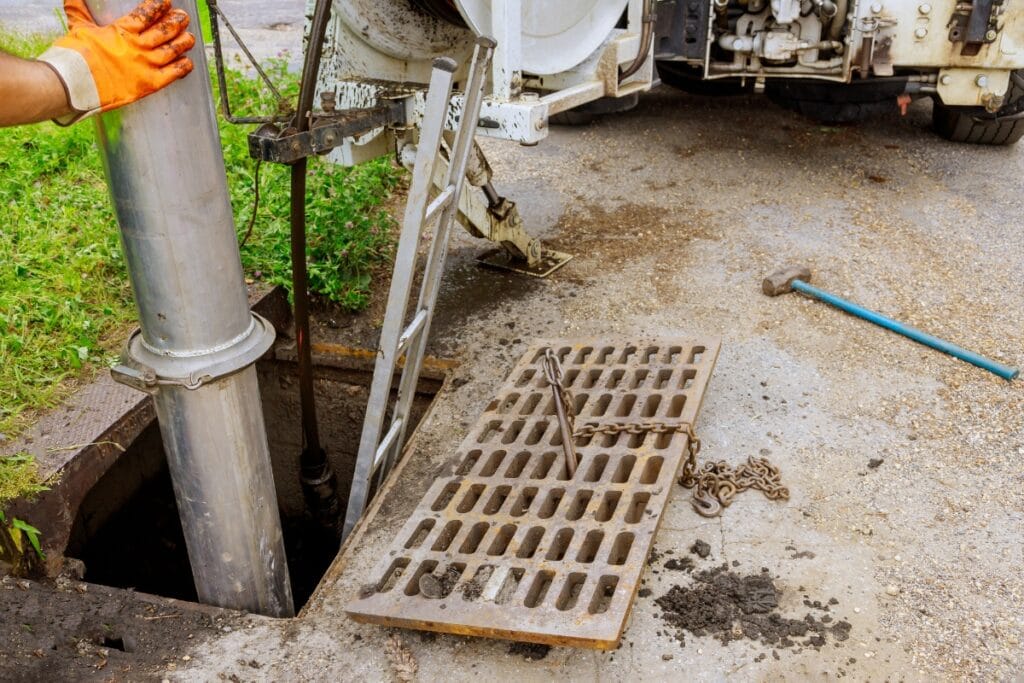
A well-installed drainage system is only effective if it’s properly maintained. Over time, even the best systems can lose performance without regular upkeep. Simple steps done consistently will help avoid bigger problems later on and keep your outdoor spaces protected.
Start with the basics: inspect all visible drainage components every few months. That includes grates, catch basins, and channel drains. Leaves, dirt, and other debris can build up quickly, especially during fall or after storms. A shop vac, stiff brush, or garden hose with a strong spray nozzle is often all it takes to clear blockages and keep water flowing properly.
For underground pipes, an annual inspection is a smart move. These systems are easy to forget about until they stop working. Look for signs like slow draining water, standing puddles near outlets, or soft spots in the yard. A professional plumber or drainage contractor can use a video scope to check for cracks, root intrusion, or heavy sediment buildup without tearing up your yard.
Don’t forget your gutters and downspouts. These often get overlooked, but they are a major part of keeping water away from your home. Clean them out regularly, especially during leaf-heavy seasons, and check that downspout extensions carry water at least several feet away from your foundation.
After heavy rainfall, walk your property and look for areas where water pools or flows in the wrong direction. These early signs of trouble are easier to fix with minor regrading, soil amendments, or an added drain. Waiting too long can lead to erosion, hardscape damage, or even foundation issues.
In short, consistent maintenance keeps your drainage system doing what it’s meant to do: move water away from your home efficiently. A little time spent each season can save you from expensive repairs and protect the long-term value of your outdoor investment.
Conclusion: Emphasizing the Vital Role of Drainage in Atlanta Hardscape Designs
Ensuring proper drainage is the cornerstone of a durable, beautiful hardscape that stands up to Atlanta’s weather conditions. Without it, even the most stunning patio or walkway can suffer from pooling water, erosion, and structural damage. By prioritizing efficient water management in your design, you protect your investment and enjoy a functional outdoor space for years to come.
For expert hardscape solutions that incorporate top-tier drainage systems, choose Atlanta Hardscape Kings. Call us at (470) 606-7895 or visit our website to fill out the form and get a free estimate—let’s build a hardscape that not only looks great but performs flawlessly.






